
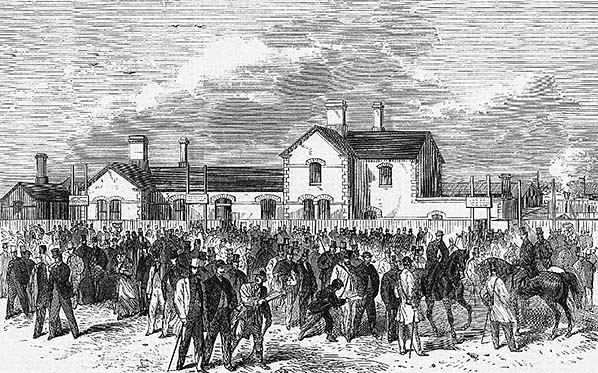 The first-ever published illustration of Epsom Downs station was the Illustrated London News Supplement published on 3 June 1865, two weeks after the Epsom Downs branch opened. It shows a large crowd of people in the extensive forecourt in front of David J Field's station building. The scene depicts Derby Day which was a few days earlier. The Illustrated London News devoted half a
page to the feature. From Illustrated London News 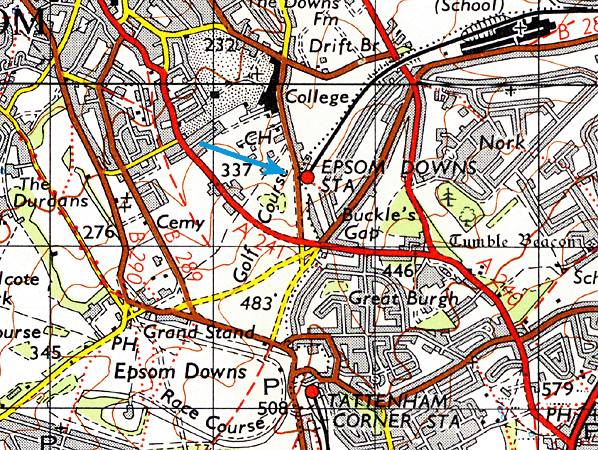 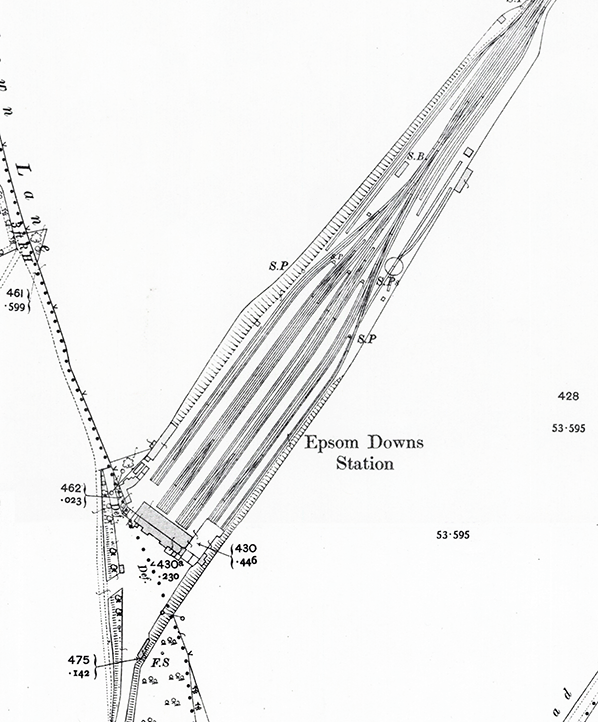
1913 1:2,500 OS map shows the layout of Epsom Downs station. The station's five platforms (four islands and a side platform) with nine faces are clearly seen. Platform 1 is the side platform on the west side. There is a large covered concourse at the end of the platforms. The main station building incorporates the station master's house on the east side. A number of buildings are seen at the back of platform 1. Their purposes are unknown but they are assumed to be related to goods traffic; the station did handle a full range of goods traffic. The large Saxby & Farmer signal box is seen on the approach to the station on the west side. Two sidings are seen running behind the signal box; these may well be private sidings. The 1904 Railway Clearing House ‘Handbook of Stations’ lists two private sidings for Messrs Gadson and Kerr. The turntable road is seen on the east side of the approach. To the north of the 42ft turntable the road splits into two with one line terminating by the water tower. Locomotive release roads are seen between platforms 2 and 3, and 4 and 5. A signal post (SP) is seen at the end of each of the island platforms. At this time there has been no residential development in the
vicinity of the station. Click here for a larger version 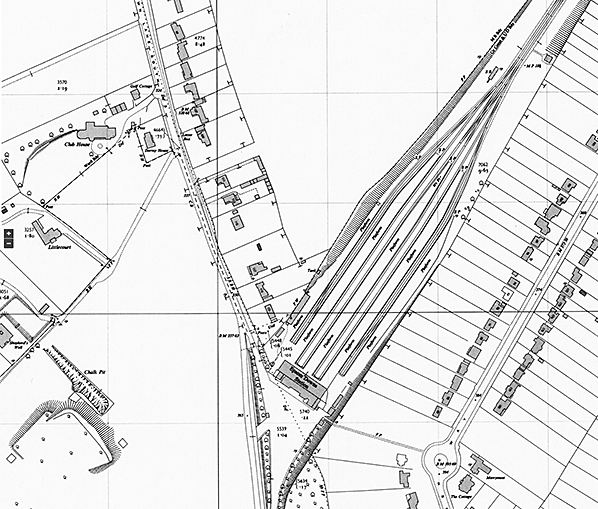
1955 1:2,500 OS map shows the track layout on the approach to the station has been considerably simplified with the removal of all the stabling lines; the release roads between the platforms have also been removed as have the two sidings running behind the signal box. The turntable and associated roads have also gone but the water tower is still seen. A watering point is noted at the end of platforms 4 and 5; these are the platforms used for the regular service. Due west of the station the structure surrounded by an earth bank is the WW2 deep air raid shelter. What is labelled as a chalk pit in front of it is, in fact, the approach cutting to the two shelter entrances. There has been considerable residential development around the station. Click here for a larger version.
downs_old6.jpg) Epsom Downs station sometime in 1873. The reason for the intense activity, with fourteen locomotives present, is unclear although it must have been a race day. The Derby Stakes, popularly known simply as the Derby, was at this time nominally held on a Wednesday during late May or early June depending upon when Easter fell, but the bare trees on the right suggest that the photograph was taken during springtime. This in turn may suggest that the occasion was the City and Suburban Handicap, a race dating back to 1851 and held in April during what is known as the Epsom Spring Meeting. Whatever the occasion, it appears to have been a wet and miserable day. Their distance from camera and the poor image quality make it impossible to identify all locomotives with any degree of certainty. To confuse the issue further, there are some Craven locomotives which have undergone Stroudley-era modifications. The locomotives on the turntable road, left, cannot be identified but appear to be spectacle-plated 2-4-0 types and at least one has a fluted dome of the style most familiar on the 'Jenny Lind' 2-2-2s. At left foreground is a Craven 2-4-0; there were four of these, Nos.174 - 177, of which No.174 was destined to explode at Lewes a few years later. In the centre of the picture is a 'Belgravia' 2-4-0 with Stroudley cab while on the right is another Craven 2-4-0 and perhaps also from the 174 - 177 batch. Behind it and standing just beyond the platform is what appears to be a Victoria class 2-2-2. Also visible are a number of LB&SCR headcode plates. At least three are circular with a central dot and are of the pre-1881 scheme of which few, if any, details appear to have survived. The Belgravia 2-4-0 is carrying an oblong plate with a coloured border and, apparently, two dots. This may have signified a station pilot, a duty which would have been necessary at busy times as not all platforms were provided with a release road. Carriages are also difficult to identify although clearly most are 4-wheelers with oil lighting. Standing on its own in the right background is a particularly ancient 3-compartment 4-wheeler of a design harking back to the 1830s. By 1873 all this stock was probably no longer in frontline service and kept 'on the books' for relief and other such occasional duties. The track, pointwork excepted, has its sleepers covered by ballast. This once common practice was not conducive to good maintenance and was destined to be outlawed for safety reasons. Epsom Downs station sometime in 1873. The reason for the intense activity, with fourteen locomotives present, is unclear although it must have been a race day. The Derby Stakes, popularly known simply as the Derby, was at this time nominally held on a Wednesday during late May or early June depending upon when Easter fell, but the bare trees on the right suggest that the photograph was taken during springtime. This in turn may suggest that the occasion was the City and Suburban Handicap, a race dating back to 1851 and held in April during what is known as the Epsom Spring Meeting. Whatever the occasion, it appears to have been a wet and miserable day. Their distance from camera and the poor image quality make it impossible to identify all locomotives with any degree of certainty. To confuse the issue further, there are some Craven locomotives which have undergone Stroudley-era modifications. The locomotives on the turntable road, left, cannot be identified but appear to be spectacle-plated 2-4-0 types and at least one has a fluted dome of the style most familiar on the 'Jenny Lind' 2-2-2s. At left foreground is a Craven 2-4-0; there were four of these, Nos.174 - 177, of which No.174 was destined to explode at Lewes a few years later. In the centre of the picture is a 'Belgravia' 2-4-0 with Stroudley cab while on the right is another Craven 2-4-0 and perhaps also from the 174 - 177 batch. Behind it and standing just beyond the platform is what appears to be a Victoria class 2-2-2. Also visible are a number of LB&SCR headcode plates. At least three are circular with a central dot and are of the pre-1881 scheme of which few, if any, details appear to have survived. The Belgravia 2-4-0 is carrying an oblong plate with a coloured border and, apparently, two dots. This may have signified a station pilot, a duty which would have been necessary at busy times as not all platforms were provided with a release road. Carriages are also difficult to identify although clearly most are 4-wheelers with oil lighting. Standing on its own in the right background is a particularly ancient 3-compartment 4-wheeler of a design harking back to the 1830s. By 1873 all this stock was probably no longer in frontline service and kept 'on the books' for relief and other such occasional duties. The track, pointwork excepted, has its sleepers covered by ballast. This once common practice was not conducive to good maintenance and was destined to be outlawed for safety reasons.Photo from John Mann collection old14.jpg) A rather delightful watercolour by PR Perry depicting Epsom Downs station on Derby Day Wednesday 5 June 1878. Four-wheel carriages predominate, together with a number of 0-6-0T locomotives which are presumably supposed to represent Class A1, better known by their 'Terrier' nickname. On the turntable is what appears to be an 0-4-2, perhaps of Class D2 (The 'Lyons') although the dome is rather too far forward for a D2. Of course, as was often the case there is a degree of artistic licence. At platform 8 stands the Royal Train with the Royal Saloon being the fourth vehicle behind the locomotive, which appears to be a representation of a 2-2-2 single driver, perhaps of Class G although this designation embraced a number of types built at various times. The Royal Train could use either platform 8 or 9 but one suspects that the artist chose platform 8, which may or may not have been used in reality in 1878, in order to depict the Royal party departing for the racecourse in their road coaches. Left of the station building the driveway and arch allowing Royalty unhindered access to and from the station can be seen and this depiction can be taken as accurate. Other examples of artistic licence are the hill in the background, the signals and the water crane beside the turntable. The hill is suspected of being exaggerated in order to show the procession of people trudging from the station to the racecourse; the latter is depicted in the distance. The signals are a crude depiction of the pre-1879 signalling and the posts are far too tall. Drivers of departing trains would have had to look up at the sky to see the position of the arms. Not every platform is signalled and this is probably deliberate by the artist in order not to obscure the foreground scene. The water crane is something of a joke and was no doubt added to the painting for effect. It would be extremely difficult, if not impossible, for a locomotive to fill its tanks from a water crane located at such a position. In all likelihood this was the water crane located further along near the water tower, assuming there was one, and the artist simply 'moved it' into the picture. The Royal Train, in reality, would have conveyed the Prince and Princess of Wales, later King Edward VII and Queen Alexandra. It is well known that following the death of Prince Albert, Queen Victoria largely withdrew from public life and resided mainly at Windsor - a situation which very nearly saw the end of the British Monarchy. During this period the Prince and Princess of Wales effectively deputised for Her Majesty, both at home and abroad. Queen Victoria did not, however, withdraw herself entirely and continued with many official engagements; for example she made several visits, usually by train, to Netley both during construction of and after opening of the Royal Victoria Military Hospital and continued to do so until shortly before her death. Her Majesty did not, of course, attend the 1878 Derby to see Sefton, ridden by Harry Constable, trained by Alec Taylor Snr. and owned by William Stirling Crawfurd win the race. Click here to see a larger version
Watercolour from Jim Lake collection 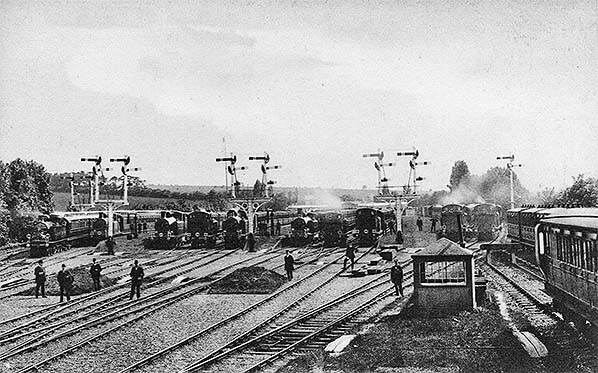
Epsom Downs station on Derby Day, Wednesday 5 June 1907, with every platform in use. Most of the locomotives, all tanks, are difficult to identify but from what can be seen all appear to be Marsh and Billinton designs with not a Stroudley in sight. At far left is the Royal Train headed by 4-4-2T No.600 of Class I1. The train was a 5-car set built in 1899 for the Prince and Princess of Wales, soon to become King Edward VII and Queen Alexandra, comprising two Diagram 86, two Diagram 87 and one Diagram 85 vehicles. The latter was the Royal Saloon and was marshalled in the centre of the train. All vehicles were 52ft long and had clerestory roofs. On 17 April 1899 the ‘Morning Post’, a London newspaper which became defunct (taken over by the ‘Daily Telegraph’) in 1937 reported that ‘the Royal Saloon is divided into two sections, the larger portion being especially fitted for the Princess of Wales, and the smaller portion for the Prince of Wales. In the matters of the decorations and furniture of the saloons the Company consulted their Royal Highnesses, whose choice rested on quiet, and at the same time artistic, ornamentation. The chief woods employed are Karri pine, Cuba mahogany, and satinwood. The inlaid panels and Lincrusta-Walton dados, in which the rose, shamrock, and thistle are designed, show great taste of skilled workmanship, and the same remark may be applied to the furniture in the saloon, which consists of sofas and easy-chairs upholstered in dark green morocco, that being the colour and material which her Royal Highness preferred to any other.’ The reference to the 'Company' means the LB&SCR and it was normal practice to consult Royalty with regard to the design of Royal Trains and remains so today. It is worth mentioning that at one time most British main line railway companies operated a Royal Train or a least a saloon and the few which did not would usually borrow a saloon from another company when required. The headcode displays seen at Epsom in 1907 relate to the LB&SCR scheme current 1881 - 1910. The Royal Train should have two 'double diamond' discs as seen here plus another of the same ahead of the chimney; the latter is absent for some reason, leading one to presume the full display was applied only when Royalty were on board the train. Coaching stock visible, Royal Train excepted, appears to comprise a selection of 4-wheel, 6-wheel and bogie stock. Some, at least, of the stock visible is gas lit as was common at the time. Other points to note are the mounds between the tracks. Quite what these were is not known. They are not ash pits and if flower beds one would expect to see blooms in June, even on a picture of this relatively poor quality. The purpose of the hut on the right is also not known. Obviously it was designed to give a clear view of the tracks so may have a signal cabin, pre-1879, or a shunters' cabin. The 1907 Derby was won by Orby, ridden by John Reiff, trained by Fred McCabe and owned by Richard Croker. An explanation of headcodes, including those of the LB&SCR, can be found at the Southern Email Group website.
Photo from John Mann collection 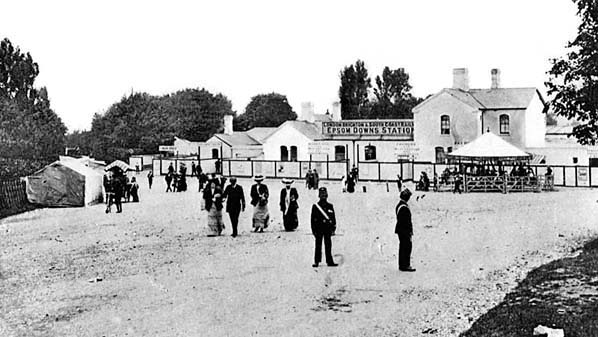
Epsom Downs station forecourt in the early years of the twentieth century, probably during a race meeting but before large numbers of people arrived at the station. A band stand has been erected on the forecourt. Note the large number of advertising posters in front of the station building.
Photo from John Mann collection 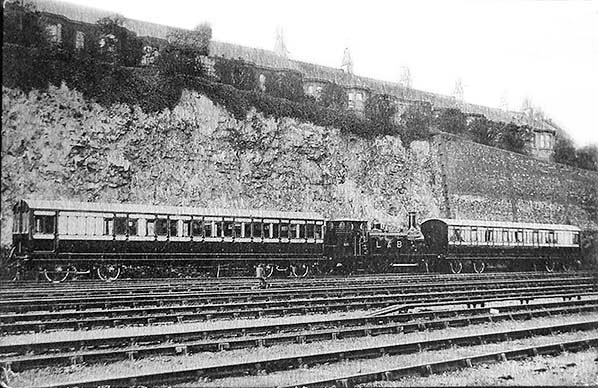
Douglas Earle Marsh took over from Robert Billinton as LB&SCR Locomotive, Carriage and Wagon Superintendent in November 1904. An unpopular man who failed to earn the respect of his workforce at Brighton, Marsh took 'early retirement' in July 1911 supposedly on health grounds in the shadow of alleged accounting irregularities. During his brief tenure, Marsh made a number of changes among which was the abandonment of Stroudley's yellow livery and the removal of passenger locomotives’ names, both features which made the 'Brighton' so well known, although there was something of a U-turn on the naming policy in 1906. Further of Marsh's ideas can be seen in this view taken during or shortly after 1909; a motor-train (referred to as a 'Rail Motor' somewhat incorrectly) or, as the type came to be known, a push-and-pull train but here with the locomotive sandwiched between a pair of driving trailers. Attempts to discover the location have failed but this type of train did operate the Epsom Downs branch, among others, and this is the reason for the inclusion of this photograph. (The photo is titled 'Rail Motor LB&SC Ry. West Croydon & Epsom Downs'). The locomotive is Class D1 0-4-2T No.625, formerly named 'Rotherfield'. Marsh had instigated the fitting of push-and-pull gear to the D1 class with No.627, formerly 'Uckfield' being the first example so treated. The L & B on the tank side was another Marsh fad; it referred not to the original London & Brighton Railway Company but was a horrendously crude abbreviation of London, Brighton & South Coast Railway which would not have looked out of place on some scruffy industrial locomotive. As far as can be determined this L & B disfigurement was applied only to the push-and-pull-fitted D1s but in any event it did not last long, thankfully, and was replaced by the plain but far more business-like L B S C lettering from 1911, following Marsh's departure in other words. At the time she was photographed No.625 would have worn dark umber with yellow lining. The driving trailers were purpose built in 1909, thus we can date this photograph to no earlier than that year and probably no later than 1912. Ten of these driving trailers were built and they originally ran either singly or as seen here. Later the practice of sandwiching the locomotive was abandoned and when a 2-car set was required various types of 'ordinary' coach were adapted. The 'sandwiched locomotive' idea was not unique to the LB&SCR, for example the Midland and the Great Eastern also dabbled with it. Whilst it might have been all very nice for drivers it was an unnecessary waste of equipment and was also a nuisance when locomotives needed releasing, when going on-shed for example. It was for these reasons that the idea met with little enthusiasm and was soon abandoned. The driving trailers as seen here would have been in umber and white livery, with the white including the roof - yet another bad practice. This batch of driving trailers could ultimately be found almost anywhere on the Southern Railway system and some of them lasted well into British Railways days before finally bowing out in 1959. Of No.625, she began life in March 1876 as No.25 and eventually became Southern Railway No.2625. A few of the class survived to see British Railways but No.2625 was not among them, bowing out in October 1940.
Photo from John Mann collection old11.jpg)
An aerial view of Epsom Downs station looking south-east in May 1922. Visible are the station buildings and all platforms, albeit with Nos.1 and 2 partly obscured by trees. It would appear that the west side platforms doubled as goods faculties and apart from on race days probably served this purpose for much of their active life. The single-storey building alongside platform 1 was probably offices and, if the gardens behind it are anything to go by, staff accommodation. The reason for the large circulating area at the head of platforms 8 and 9 is unclear but was probably for the benefit of royalty and entourage as the Royal Train seems to have usually used these platforms. It is likely that road vehicles waited here to transport the regal arrivals onward to the racecourse. Towards top left can be seen the locomotive turntable with, to its left, what appears to be a grounded van body in use as a hut. Not at all clear in this view is that south of the turntable, i.e. to its left, the turntable road split into two sidings but of unequal length with the shorter being furthest from the camera. At the end of the longer siding once stood a water tower (out of view in this picture) but little is known about it. The signal box, centre left, dated from 1879. It contained a 72-lever frame of the Saxby & Farmer spindle-locking type which had served at London Bridge from 1866 until 1878. Despite being modified to tappet-locking in 1908, it became the last in-use surviving frame of its type and remained in operation until the box was destroyed by fire on 16 November 1981. At some point in Southern Railway days the box was given an additional 2-lever frame to operate detonator-placing equipment. Click here for a larger version.
Photo from Britain from Above reproduced under the terms of their non-commercial licence old12.jpg)
An aerial view of Epsom Downs station, recorded only as having been taken during May 1922. On the forecourt are a number of haphazardly parked motor cars, this of course being long before the days of parking spaces marked out with white lines. Parked in a more orderly fashion alongside the belt of trees are some more upmarket motor cars, perhaps of Rolls-Royce manufacture. The presence of these motor cars implies it might be Derby Day but before a flood of trains arrived. The 1922 Derby took place on Wednesday 31 May and was won by Captain Cuttle, ridden by Steve Donoghue, trained by Fred Darling and owned by James Buchanan, 1st Baron Woolavington. A British Pathé film of the 1922 Derby can be viewed via the link. Platform 1 is occupied mainly by vans while some passenger stock is visible in platform 2. A passenger train has arrived at platform 5 behind what appears to be one of the Robert Billinton 0-6-2Ts, probably an E4. The island platform farthest from the camera (platforms 8 and 9) appears to have had a grass strip along its centre-line and if so was no doubt intended for the benefit of arriving and departing Royalty. Unfortunately the only photographs which have come to light giving unobstructed views of this platform from ground level were taken after it fell into disuse, by which time nature had taken over anyway.
Click here for larger version. Photo from Britain from Above reproduced under the terms of their non-commercial licence old15.jpg) The old saying ‘there's never one around when you need one’ did not ring true for the photographer on this occasion as swarms of police officers leave Epsom Downs station on Derby Day, Wednesday 4 June 1924. If the date were not known, this scene would be difficult to date and the Southern Railway sign nominally applied for only 25 years but such signs continued to exist well into BR days. One clue would be the police uniforms; close examination shows they have their warrant numbers on their collars and this identifies the photograph is pre-war. The officers are most likely from the Metropolitan Police for at this time the 'Met' also covered areas of Surrey, including Epsom, which were then well beyond the boundary of what we know today as Greater London. This situation prevailed until as late as 2000 when the areas concerned came under the jurisdiction of Surrey Police. The officers arriving at Epsom in 1924 would have been drafted in from various Metropolitan Police divisions and taken to Epsom by special train. The job of the officers, who likely walked from the station to the racecourse, would have involved security for the royal party (King George V and Queen Mary), crowd and road traffic control and general policing. Then as now, events such as the Derby were magnets for criminals, with pickpockets being a particular problem and more so pre-war. The majority of officers seen here are constables but at least one sergeant is visible, foreground, with, behind him, what is probably a detective. Right of centre is an officer wearing a peaked cap, as opposed to helmet, and he will be of a more senior rank, inspector perhaps. The marquee on the left will be connected with the Derby and probably served as an information centre or perhaps a refreshment stall. On the wooden hut is an advertising poster encouraging people to sample the delights of Littlehampton. These delightful posters are now relics of a bygone age and we are unlikely to see the likes of them again. Today posters warn of the dire consequences of boarding a train with the wrong type of ticket, warning passengers about unattended baggage and the 'we regret to Inform you' type notices. The sign on the wall of the station building informs the public they can ‘book here for Sutton, West Croydon, Norwood Jct, Forest Hill and New Cross Gate’. Signs such as this, a form of advertising, were once very common and especially in the London area. In reality they were rather pointless as most people were well aware that they could turn up at a station and buy a ticket and not just to stations listed, which tended to be only stations which did not involve a change of train en-route. The sign at Epsom Downs made no mention of London termini and this practice was also not uncommon. This photograph gives little hint that the 1924 Derby was one of the worst on record with regard to weather. The racecourse, it is said, was reduced to a sea of mud but attendance was nonetheless a record and this caused some problems with traffic control, overseen by police aloft in a tethered balloon. The race was won by Sansovino, ridden by Tommy Weston, trained at Newmarket by George Lambton and owned by Edward Stanley, 17th Earl of Derby. Stanley - a highly decorated man who had a distinguished career and was a descendant of the 12th Earl of Derby after whom the Derby Stakes was named.
Photo from Jim Lake collection old6.jpg) An interesting view of the desolate expanse of Epsom Downs station, believed photographed during 1928. The signal posts hold Home, Up Starter and Shunt arms although that at far right appears to lack a Shunt arm. Many years later, in December 1969, the Epsom Downs branch was fitted with automatic colour-light signals and all intermediate boxes were abolished. The exception was Epsom Downs station which retained semaphore signals, by then of the upper quadrant type, until the slightly premature destruction of the signal box. Waiting at the end of platform 5 is a Class D1 0-4-2T with what is almost certainly a push-and-pull train formed of an ex LB&SCR 'Balloon' Driving Trailer Third with one other carriage. The 'one other carriage' formed into these sets were originally trailers from former LB&SCR overhead electric units but from 1921 the Southern replaced them with arc-roofed composites. This photograph is by no means clear but the carriage in question appears to be of the latter type. Quite why the train is posing at the end of the platform with signals showing ‘Stop’ is not known but the logical conclusion is the train having drawn forward for the locomotive to take on water. It was normal practice in these circumstances for push-and-pull locomotives to remain attached to their trains. The passenger stock stabled in the background might be awaiting a peak hour service and from what shadows can be seen this photograph was taken during the early morning. Two years later, electric services commenced and conductor rail can be seen already in position on the roads serving platforms 5 and 6. Close examination suggests conductor rail is also in position on the roads serving platforms 3 and 4. Not every platform had a water column and such provision would not have been necessary for the normal passenger service, but quite what arrangements were put in hand on busy race days is not known. There was a water tower situated on the down side and just north of the turntable roads but it is not known if watering facilities were also provided at that point.
Photo from RC Riley collection Click here for Epsom Downs Station Gallery 2:  Home Page Home Page
|

 Notes: The first recorded race was held on the Downs in 1661. Epsom is referenced in the diary of Samuel Pepys in 1663 and Charles II is said to have been a racegoer there. By 1684, Epsom had a clerk of the course and from 1730 was hosting twice-yearly race meetings. With large numbers of passengers travelling to Epsom to visit the Epsom Downs Racecourse, it became clear that a station near the course was needed. Attempts to build one immediately next to it were strongly opposed by both the Lord of the Manor of Epsom Downs and the Epsom Grandstand Association and eventually land was purchased half a mile from the course which was to become the terminus of a short branch from Sutton known as the Banstead & Epsom Downs Railway.
Notes: The first recorded race was held on the Downs in 1661. Epsom is referenced in the diary of Samuel Pepys in 1663 and Charles II is said to have been a racegoer there. By 1684, Epsom had a clerk of the course and from 1730 was hosting twice-yearly race meetings. With large numbers of passengers travelling to Epsom to visit the Epsom Downs Racecourse, it became clear that a station near the course was needed. Attempts to build one immediately next to it were strongly opposed by both the Lord of the Manor of Epsom Downs and the Epsom Grandstand Association and eventually land was purchased half a mile from the course which was to become the terminus of a short branch from Sutton known as the Banstead & Epsom Downs Railway.  Epsom Downs was provided with a large signal box built for the LB&SCR by Saxby & Farmer in 1879. The box was 42ft in length and was fitted with two lever frames, a Saxby & Farmer spindle frame of 50 levers and a 25-lever Saxby & Farmer rocker locking frame which was fitted in 1908. A 42ft turntable was provided on the east side of the approach line. To the north of the turntable the road divided into two with one road terminating at a standard design brick LB&SCR water tower.
Epsom Downs was provided with a large signal box built for the LB&SCR by Saxby & Farmer in 1879. The box was 42ft in length and was fitted with two lever frames, a Saxby & Farmer spindle frame of 50 levers and a 25-lever Saxby & Farmer rocker locking frame which was fitted in 1908. A 42ft turntable was provided on the east side of the approach line. To the north of the turntable the road divided into two with one road terminating at a standard design brick LB&SCR water tower.
 Despite the decline in race traffic the area around the station saw considerable residential development in the 1920s which brought new commuter traffic to the branch.
Despite the decline in race traffic the area around the station saw considerable residential development in the 1920s which brought new commuter traffic to the branch. In 1940 five deep level air-raid shelters were proposed by Surrey County Council. The shelters were all to be located close to railway stations but in open country or on the outer fringes of the built-up areas. One of the selected sites was 300yd west of Epsom Downs station which, in 1941, fronted the road. The shelter would provide accommodation for 1,500 persons in bunks; included would be electric lighting (mains and emergency), ventilation, water supply, sanitary conveniences and drainage, blast- and gas-proof entrances, first-aid rooms, and duck-boards. The claim was made that shelter accommodation in deep tunnels would be cheaper per head than in numerous surface, basement or shallow shelters. It seems likely that the overall plan for each shelter was standard, with three parallel tunnels into the hillside linked by six lateral tunnels at right angles to them. The Longdown Lane shelter was below road level entered via a sloping path in a cutting.
In 1940 five deep level air-raid shelters were proposed by Surrey County Council. The shelters were all to be located close to railway stations but in open country or on the outer fringes of the built-up areas. One of the selected sites was 300yd west of Epsom Downs station which, in 1941, fronted the road. The shelter would provide accommodation for 1,500 persons in bunks; included would be electric lighting (mains and emergency), ventilation, water supply, sanitary conveniences and drainage, blast- and gas-proof entrances, first-aid rooms, and duck-boards. The claim was made that shelter accommodation in deep tunnels would be cheaper per head than in numerous surface, basement or shallow shelters. It seems likely that the overall plan for each shelter was standard, with three parallel tunnels into the hillside linked by six lateral tunnels at right angles to them. The Longdown Lane shelter was below road level entered via a sloping path in a cutting.  Tunnelling probably started in 1941 and was well underway by May. Following an inspection of the shelter on 12 May 1941 it was suggested that, in order to test the safety of the tunnels, a bomb should be exploded over the shelter to observe the effects. This exercise was carried out at the Longdown Lane shelter on 10 June. A 550-pound German bomb was placed ‘dead centre’ over one of the tunnels. The bomb had been sunk to a depth of 23ft 6in below ground level in ‘solid chalk’, 18ft 6in above the tunnel roof. Mice and canaries in cages, and instruments for measuring vibration, had been placed at various points underground. The device was detonated by Ministry of Home Security Research Department staff with no reported effects on the animals or birds, although ‘some chalk fell within a 16ft radius of the point immediately below the bomb’.
Tunnelling probably started in 1941 and was well underway by May. Following an inspection of the shelter on 12 May 1941 it was suggested that, in order to test the safety of the tunnels, a bomb should be exploded over the shelter to observe the effects. This exercise was carried out at the Longdown Lane shelter on 10 June. A 550-pound German bomb was placed ‘dead centre’ over one of the tunnels. The bomb had been sunk to a depth of 23ft 6in below ground level in ‘solid chalk’, 18ft 6in above the tunnel roof. Mice and canaries in cages, and instruments for measuring vibration, had been placed at various points underground. The device was detonated by Ministry of Home Security Research Department staff with no reported effects on the animals or birds, although ‘some chalk fell within a 16ft radius of the point immediately below the bomb’.  In 1969 all but platforms 4 and 5 were taken out of use with the track eventually being lifted. On 21 December 1969 intermediate signal boxes on the branch were abolished when coloured light signalling was installed between the terminus and Sutton. The Epsom Downs terminus retained its box and most of its semaphore signals although the track layout was by now substantially simplified serving just a single island platform which was renumbered platforms 1 and 2.
In 1969 all but platforms 4 and 5 were taken out of use with the track eventually being lifted. On 21 December 1969 intermediate signal boxes on the branch were abolished when coloured light signalling was installed between the terminus and Sutton. The Epsom Downs terminus retained its box and most of its semaphore signals although the track layout was by now substantially simplified serving just a single island platform which was renumbered platforms 1 and 2. The signal box was scheduled to close in 1982 in connection with the resignalling of the area (controlled from a box named Victoria but actually located at Clapham Junction). This closure was however pre-empted when the signal box was destroyed by a fire on 16 November 1981. Through workings on the branch immediately ceased with a shuttle service between Sutton and Epsom Downs being introduced allowing the branch to operate as a single-line dead-end branch under the ‘one engine in steam’ rule.
The signal box was scheduled to close in 1982 in connection with the resignalling of the area (controlled from a box named Victoria but actually located at Clapham Junction). This closure was however pre-empted when the signal box was destroyed by a fire on 16 November 1981. Through workings on the branch immediately ceased with a shuttle service between Sutton and Epsom Downs being introduced allowing the branch to operate as a single-line dead-end branch under the ‘one engine in steam’ rule. On 13 February 1989 a new station with a single platform was opened 21ch (462yd) short of the original one. The old station and platforms were demolished almost immediately and the land in between given over to a major housing development. The replacement station was installed by British Rail under the Network Southeast sector. The old station and the line to the north-east roughly follows the line of Bunbury Way.
On 13 February 1989 a new station with a single platform was opened 21ch (462yd) short of the original one. The old station and platforms were demolished almost immediately and the land in between given over to a major housing development. The replacement station was installed by British Rail under the Network Southeast sector. The old station and the line to the north-east roughly follows the line of Bunbury Way.
